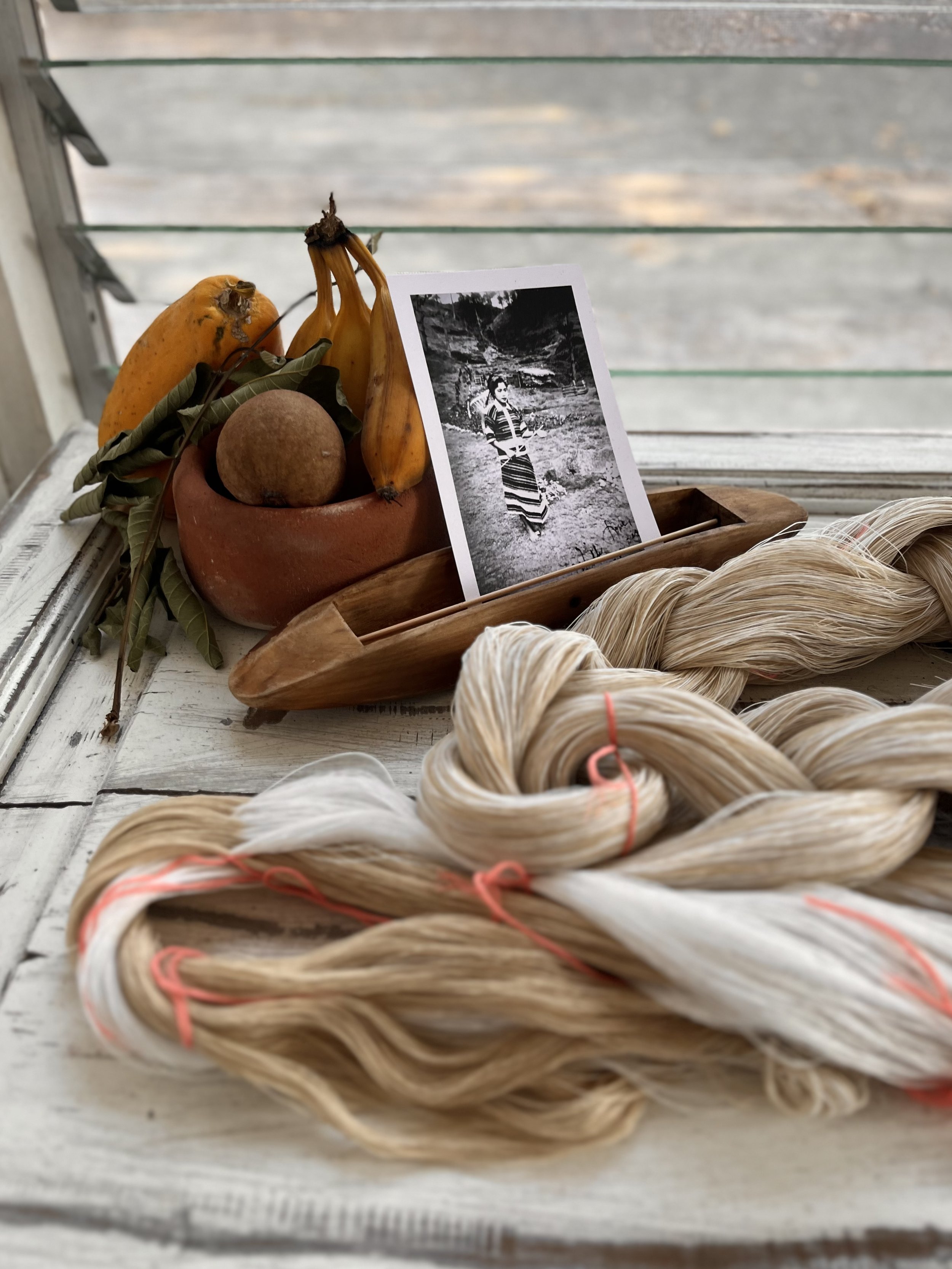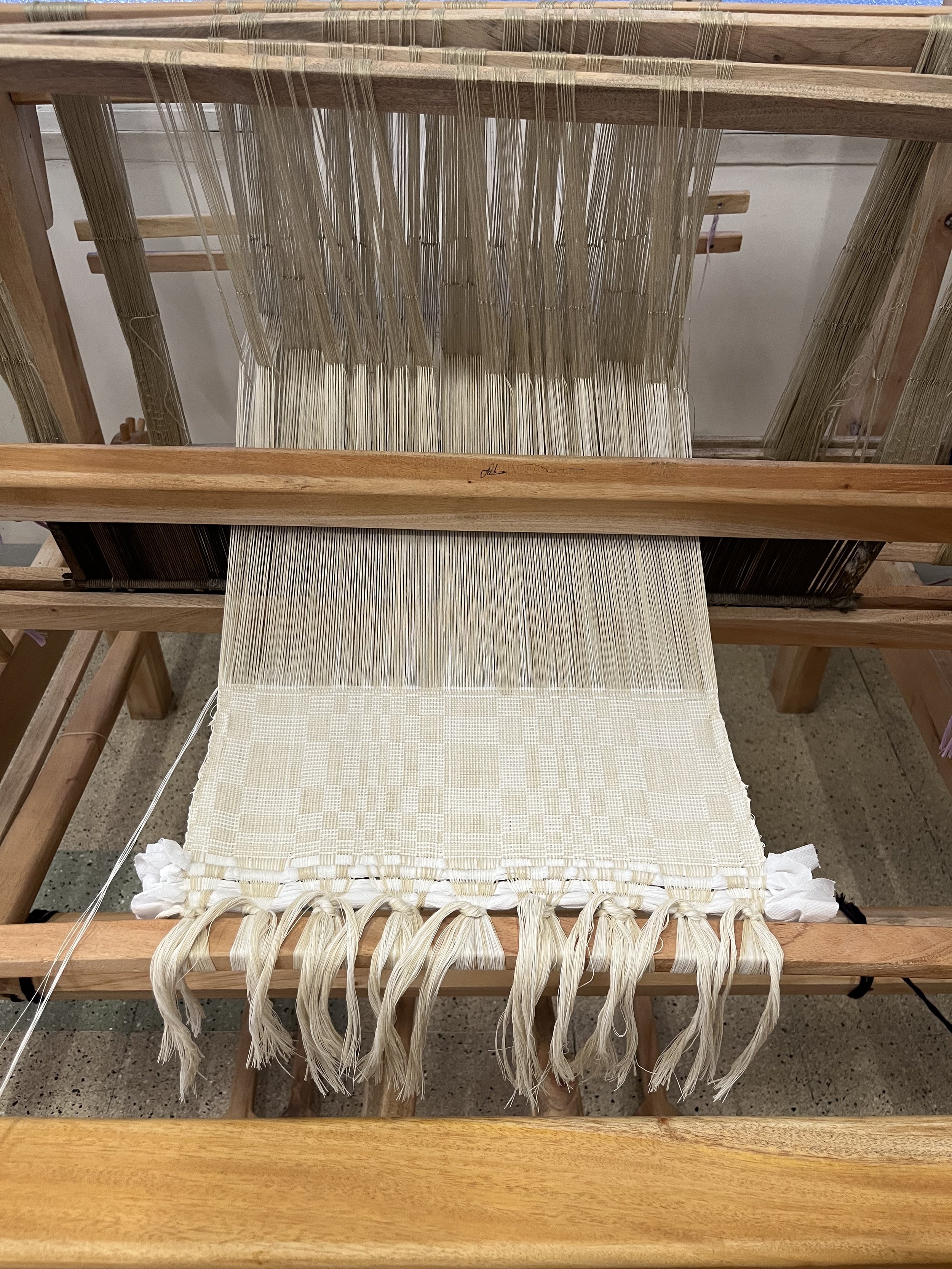
ISSUE 07 | FALL/WINTER 24/25
A WOVEN LINEAGE: CAROL ANN APILADO’S JOURNEY OF REVIVING HER ILOCANO WEAVING ROOTS
By Khadra Ahmed
When Carol-Ann Apilado bought an eyecatching rug, she had no idea the almost-lost family lineage it would unveil, nor how it would launch her artistic practice onto a new trajectory.
Born in Oslo, Norway, Carol-Ann moved to Brampton, Ontario with her parents when she was two years old. Growing up in a multicultural community, Carol-Ann felt very connected to and comfortable with her Filipino heritage. However, as she began practicing as a professional designer in Toronto, she encountered racism and discrimination in the city’s predominantly white art scene.
She started creating street art in 2012 and was introduced to the Kapisanan Philippine Centre for Arts and Culture in 2015 when she was cocurating at an exhibition related to the practice. The centre was a breath of fresh air in the city. Here, she learned how to view racist encounters critically and deepened her understanding of the diversity of Filipino culture.
One day, a friend she had met through the centre shared a rug on social media. Its psychedelic pattern caught Carol-Ann’s eye. What started as an innocent attraction evolved into something deeper when Carol-Ann discovered that the rug’s pattern was Indigenous to where her family was from, the Ilocos region of the Philippines.
The Kusikus pattern, which translates to “whirlwind” in Ilocano, is believed to date back to the 1500s. Ilocano weavers would create this pattern on wind sails and blankets to appease the Wind God Apo Angin and provide protection as it is believed that the psychedelic pattern confuses and wards off evil spirits.
Photo by Simay Ozturk



Photos by JJ Buenaventura
Looking back, it seemed like fate was weaving the perfect string of events: street art led CarolAnn to Kapisanan, and Kapisanan led her to the friend who just happened to post the Kusikus rug at a time in Carol-Ann’s life when she needed protection.
“Kusikus is protective and that was something I felt I needed in my life because I was creating more boundaries and I needed to protect my energy,” she recalled. “It was a symbol for the kind of medicine I needed.”
When she showed her father the rug, he casually asked her, ‘You’re interested in weaving?’ before nonchalantly dropping the family lore that would change Carol-Ann’s life completely: ‘Did you know that your Lola (grandmother) comes from a family of weavers?’
“I was shocked, and I was just like, ‘How am I supposed to know without you telling me?’” Carol-Ann remembered asking her father. “That’s something I find common with a lot of people in the diaspora. Our parents don’t tell you anything until you ask the questions.”
It turns out, Carol-Ann comes from a lineage of weavers from Bangar, one of the major weaving towns in the Philippines located in the Province of La Union. However, her family stopped weaving after Carol-Ann’s Lola, Susana Acosta Padilla Apilado, was encouraged to become a teacher, rather than a weaver. A quick moment on social media had revived an almost-lost ancestral practice and Carol-Ann’s creative spark.
“That was when things kind of clicked for me, especially as a creative and practicing artist, because at that time I was doing a lot of set design work and I was burning out,” she said. “Something just felt wrong. But when I learned about my lineage, it felt like everything made sense.”
Then, the pandemic hit.
Unable to take lessons, she patiently studied Kusikus in any way possible: drawing, painting, and making prints of the pattern. In 2022, CarolAnn decided to buy her own floor loom, pulled up a YouTube tutorial, and started teaching herself how to weave. While it runs in her blood, the initial steps toward becoming a weaver were challenging and lonely, especially with the travel restrictions in place.
“I cried because I really wanted mentorship, and I wish I could have gone home to learn from weavers [in the Philippines].”
But she pushed through, experimenting with her loom and eventually creating contemporary traditional-style works shown in art exhibitions around Toronto. In 2024, Carol-Ann’s wish to practice in community was fulfilled when she travelled to La Union to become the Balay da Judge Artist-in-Residence. A full-circle moment, CarolAnn practiced her Lola’s craft in a library that was once the maternity ward her mother worked in as a nurse before leaving the Philippines.



Photos by Carol-Ann Apilado
For several hours over a span of two months, she practiced with the help of local weaver Jana Acosta and Jana’s niece Agnes Javilo. She even had a traditional loom built for her with the help of carpenter Jefferson Acosta. Growing her roots in the city her parents grew up in, Carol-Ann felt like her residency centred around returning home.
“I felt closer to my Lola and my lineage, especially since I didn’t get to know her because she was in the Philippines, and she died over 20 years ago,” she explained. “I felt like I could understand [my family] better. I questioned why they stopped weaving, but as I weave, I understand why.”
Carol-Ann was surprised to learn that traditional weaving is also becoming a lost craft in the Philippines, mostly due to the time-consuming and low-paying nature of the craft. Like Lola Susana, many weavers were encouraged to pursue other careers to survive. Those who continue to weave are underpaid, undervalued, and forced to create textiles that appeal and sell to the Western world. While those in the diaspora often think about how we’ve become disconnected from our cultures, Carol-Ann’s residency in the Philippines showed her that colonization and imperialism can also [up]root communities in our homelands.
“I met people attending my workshops [in the Philippines] who told me the same things that people here have told me — that they wish there were more opportunities to learn how to weave these patterns. Weavers back home are just busy weaving to survive and meet their daily quotas. They don’t have the time and privilege to teach.
“Because of Western imperialism and occupation, traditions are getting lost more and more every generation, and I think it just emphasizes the importance of the work other practitioners and I are doing to pursue knowledge. I met people who were born and raised in the Philippines but know nothing about [Indigenous] plant medicines, and it’s just sad and scary. So it’s not just the diaspora who are uprooted. It’s also people back home.”
Through weaving, Carol-Ann discovered that she has another trait passed down from her Lola Susana: a passion for teaching. Outside of teaching weaving, one of her goals is to change perceptions of the Philippine textile industry.
“I want people to understand the value of our traditional practices and question: How much are the weavers getting paid? What are their names? Where do they come from? What’s the significance of these icons and motifs and symbols? I price my work pretty high, so I hope that people will think ‘Oh, this handwoven work I got from the Philippines should actually be worth much more than ten dollars.’”
In La Union, Carol-Ann dreams of turning Lola Susana’s house into an educational hub where weavers can teach and practice outside economic pressure. But before putting this in motion, Carol-Ann is carefully thinking about how to navigate the complex fabric of Filipino identity.
“The Philippines is complicated. There are levels of exploitation that people don’t always see or talk about. I would like to show my work as far as I can, but I would also like to show the work of weavers back home so that they can also be artists if they want to be artists. There are so many questions, and I don’t want to force people to do things. I’m just leaving it open and seeing how things go.
“As diaspora, what responsibilities do we have [to our homeland] without downplaying our experiences too?”
Check out Carol Ann’s weaving on IG at @carolannapilado

